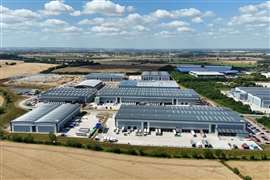Strong growth
24 April 2008
Construction output in eastern European countries is set to grow by an average of +7% in 2006, according to the latest report by construction forecasting group Euroconstruct. In the context of the current worldwide boom in construction, this growth may not sound significant but it is when compared to the predicted construction growth in Europe this year of +2,6%.
Nonetheless, the Central and Eastern European (CEE) region isn’t quite ready to take over as the construction powerhouse of Europe.
Euroconstruct valued the construction output in Eastern Europe at € 51,5 billion in 2005 and predicts that it will to grow to € 63 billion by 2008. However, output in 2005 only represents 4% of the total construction output in Europe, although the region’s share of the market is growing - in 2002 it represent 3,7% and is expected to reach 4,7% by 2008.
Strong growth in the region is being driven by numerous EU-funded projects getting underway following accession of 10 countries in the Central and Eastern European (CEE) region to the EU in May 2004. With Bulgaria and Romania set to join the EU next year, and Croatia and Macedonia also looking for membership, the volume of EU- funded projects in the CEE region is set to continue growing.
Euroconstruct is predicting the strongest growth in 2006 to be in the Slovak Republic and Poland, with gains of +9,0 and +8,9%, respectively, but high levels of growth are also forecast for Hungary (+5,1%) and the Czech Republic (+4,8%).
A recent report by the European Construction Industry Federation (FIEC) is slightly more reserved but still positive about growth in CEE. FIEC expects the strongest performance this year to come from the Czech Republic with +6,5% and also expects good results in Hungary (+5,1%), Slovakia (+5,0%) and Romania (+3,0%).
Growth Sectors
EU-funded infrastructure development means that the civil engineering sector is expected to be one of the fastest growing in the CEE region over the next few years. Euroconstruct has estimated that civil engineering work in the region will expand by +11,3% this year and increase slightly to +11,6% and +11,9% in 2007 and 2008, respectively.
FIEC also expects the recent infrastructure investment trend in East Europe to continue and growth in the next few years will be boosted by this region addressing its housing needs - both new construction and renovation. Euroconstruct predicts that new house building will rise steadily this year (+4,6%) and next year (+6,8%) before growing strongly, by around +10,3%, in 2008.
Formwork specialist Doka, has said that it is already witnessing a boom in new residential construction in the CEE region, particularly in Romania. “Construction of residential developments is rapidly increasing in Romania’s capital Bucharest,” said a company spokesman.
Reforms Needed
However, a report from the World Bank suggests that most CEE countries need to undertake more domestic reforms to benefit fully from the current growth in their general economies. According to the study, without such reforms two regional trading blocs will be formed - one of faster- reforming, richer countries with ties to Western Europe and the other of slower-reforming, poorer nations focussed on Russia.
The report, ‘From Disintegration to Reintegration: Eastern Europe and the Former Soviet Union in International Trade’, analyses the evolution of trade in 27 former Communist countries. The findings of the study show that over the last 10 years, exports have tripled and imports have risen two and a half times, which is faster than any other region worldwide.
The World Bank claims that this rapid rise in trade is one of the main drivers of development in the CEE region but some countries have capitalised on this better than others. The report suggests that the most prosperous CEE countries, such as Poland and Hungary, have matched liberal trade reforms with ‘behind-the-border’ structural and institution reforms. But the relatively closed trade regimes within countries like Belarus and Uzbekistan is holding back development.
The European Bank for Reconstruction and Development (EBRD) has recently published new strategies for a number of CEE countries, including the Slovak Republic, Macedonia and Estonia. These strategies are designed to help these countries overcome the economic challenges to achieve long term growth and prosperity. The EBRD hopes to achieve its aims through encouraging private investment, including infrastructure development via public private partnerships (PPP).
Private Investment
Payment for road construction through toll roads is already common in CEE but procurement through PPP has yet to take off in the region. However a number of countries are already looking at the model as a cost effective route to building new infrastructure.
However, Poland is already ahead of the game and is in talks with a number of private companies about the use of PPP to build 300 km of its A1 and A2 motorways. The country’s government has said that the PPP solution could provide it with an alternative to the inefficient licensing system which private companies currently have to go through to undertake road construction work.
Germany-based Hochtief believes that PPP will be big business in the region in the future and has set up a division - Hochtief PPP Solution - to tap into the potential market. The new division is involved in two possible Polish PPP motorways and the company has said it expects tenders for projects in the Czech Republic, Slovakia, Russia, Bulgaria and Romania to be issued in the near future.
Poland is also leading the way when it come to privately funded port development. British consortium DCT is funding Europe’s first privately financed container terminal in Gdnask, and hopes the new port with become a trade hub for the CEE region.
The exact value of the Gdansk Harbor project, which is being undertaken by Hochtief and is due to be completed in late 2007, has not been revealed but is believed to be more than € 100 million. The finished terminal will include an 800 m long, 315 m wide pier - which will be back filled with 5,4 million m3 of dredged material, a rail link, and warehousing.
Equipment Boost
Like Hochtief, many German construction companies, together with Swedish, French and Spanish contractors, are now active in the CEE region - capitalising on growth in the CEE market has helped them to survive the decade long construction recession in Germany (see CE, September 2006). But the CEE region is also providing a profitable boost for the German construction equipment market too.
“Sales of new construction equipment is rising in Germany because the growth in CEE countries is creating a ready market for the sale of used equipment,” said Verband Deutscher Maschinen und Angelbau (VDMA) - Germany’s construction equipment and building machinery association - deputy managing director Dr Peter Hug. “Many German contractors are working on projects in the CEE region and taking existing equipment fleets with them, and then selling the machines after the work is completed.”
Further Growth
Prospects for further growth over the next few years in the CEE construction market look good despite a poorer outlook for Europe as a whole. Euroconstruct expects construction growth in Europe to peak in 2006 at +2,6% before dropping back to +1,7 and +1,8% in 2007 and 2008. However, construction output in Eastern Europe is predicted to remain steady next year at +6,7% before increasing again in 2008 to +8,0%.
According to Euroconstruct, Hungary is likely to be the best performing construction market in the next few years, with output growing to +7,9% next year and +12,0% in 2008.
The Czech Republic’s construction sector is estimated to grow +5% in 2007 and +5,3% in 2008. Poland and the Slovak Republic are predicted to loose some ground in 2007 but remain robust at +7,2 and +7,3%. Poland is expected to recover in 2008 with growth of +8,0% but a further drop is predicted for the Slovak Republic (+5,9%).




